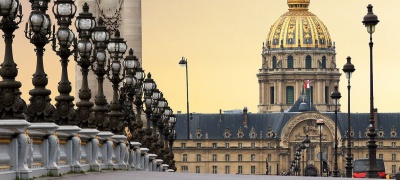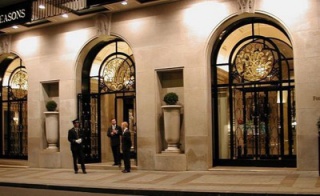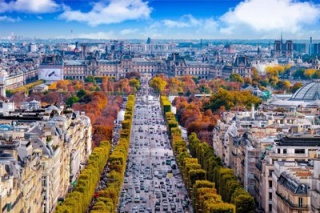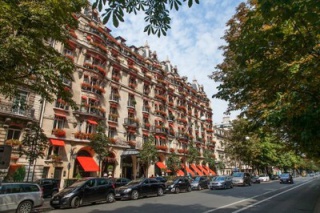Sotheby's International Realty
- 138 Avenue Victor Hugo
- 75116 PARIS, France
- +33 1 40 60 50 00
Sotheby's International Realty
- 50 rue d'Auteuil
- 75016 PARIS, France
- +33 1 56 26 56 55
Sotheby's International Realty
- 82 Avenue de Wagram
- 75017 PARIS, France
- +33 1 46 22 27 27
Sotheby's International Realty
- Place Sainte Foy - 2 Rue de Chézy
- 92200 NEUILLY, France
- +33 1 41 43 06 46
Sotheby's International Realty
- Place Sainte Foy - 2 rue de Chézy
- 92200 NEUILLY, France
- +33 1 41 25 00 00
Sotheby's International Realty
- 37-39 rue de Turenne
- 75003 PARIS, France
- +33 1 48 87 14 41

Paris 8th district -Golden Triangle
The 16th district
The Golden Triangle, located in the 8th arrondissement of Paris, is the holy of holies of French luxury. Bounded by the avenues Montaigne, George V and des Champs-Élysées, this emblematic district sparkles with world-renowned boutiques, prestigious palaces and Michelin-starred restaurants.
It's the epicenter of haute couture, where the most prestigious fashion houses compete to attract an international clientele in search of exclusivity.
But the Golden Triangle is more than just a showcase for luxury: it also offers a privileged living environment. The elegant Haussmann-style buildings lining its avenues are home to sumptuous apartments, offering spacious, refined living spaces. This prestigious district also boasts a thriving cultural and artistic life, with numerous museums, art galleries and theaters close by.
Finally, its central location makes it an ideal place to live and enjoy all that the capital has to offer, from romantic strolls along the Seine to lively evenings out in the many trendy restaurants and clubs. In short, the Golden Triangle in the 8th arrondissement is much more than just a chic neighborhood; it's a true symbol of luxury and the French art of living, where every moment is an ode to elegance and refinement.
Real Estate in the Triangle d'Or: Estimating the Value of Your Prestige Property
Located in the heart of Paris’s 8th arrondissement, between Avenue Montaigne, Avenue George V, and the Champs-Élysées, the Triangle d’Or is one of the most iconic and sought-after areas in the capital. In this ultra-prime location—where architectural elegance meets international luxury—every property demands a highly precise valuation that takes into account its exact location, features, and rarity.
The consultants at Paris Ouest Sotheby’s International Realty, experts in luxury real estate within the Triangle d’Or, offer their deep market knowledge and expertise to support you with discretion, precision, and a refined understanding of high-end property valuation.
For a free, bespoke, and confidential valuation of your property in the Triangle d’Or, contact our team at +33 1 40 60 50 00 or fill out our online form.

Avenue George V
Avenue George V, nestled in the 8th arrondissement of Paris, is the epitome of French luxury and refinement. Avenue George V is one of the most prestigious addresses in Paris. It is home to luxury boutiques, palaces, restaurants and nightclubs. The most famous of these are the Hôtel George-V, the capital's famous Art Deco palace, and the Crazy Horse Saloon, one of Paris's most famous cabarets.
Flanked by imposing buildings, renowned boutiques and prestigious palaces, this prestigious avenue attracts an international clientele in search of an exclusive experience.
To stroll along Avenue George V is to immerse oneself in a world of sophistication and opulence, where the great fashion houses compete in ingenuity to captivate visitors. But beyond its commercial character, Avenue George V also offers an exceptional living environment. The residences that line it offer top-of-the-range apartments, with breathtaking panoramic views over the city and luxurious interiors. You'll also find a number of private mansions nestling in the adjacent streets.
What's more, its central location makes it an ideal base from which to explore the cultural and architectural treasures of Paris, with its proximity to numerous museums, historic monuments and iconic sites. In short, Avenue George V epitomizes French luxury and art de vivre, where every moment is an ode to elegance and exclusivity.
An iconic address in Paris’s Golden Triangle, Avenue George V is the epitome of Parisian luxury. Lined with private mansions, five-star hotels, haute couture boutiques, and prestigious residences, this avenue attracts an international clientele in search of exceptional properties. In such a rare and ultra-exclusive market, every property requires a meticulous, confidential, and fully tailored valuation.
The consultants at Paris Ouest Sotheby’s International Realty, specialists in luxury real estate on Avenue George V, bring their expertise and high standards to guide you with precision and discretion.
High-End Property Valuation on Avenue George V
An iconic address in Paris’s Golden Triangle, Avenue George V is the epitome of Parisian luxury. Lined with private mansions, five-star hotels, haute couture boutiques, and prestigious residences, this avenue attracts an international clientele in search of exceptional properties. In such a rare and ultra-exclusive market, every property requires a meticulous, confidential, and fully tailored valuation.
The consultants at Paris Ouest Sotheby’s International Realty, specialists in luxury real estate on Avenue George V, bring their expertise and high standards to guide you with precision and discretion.
For a free, bespoke, and no-obligation valuation of your property on Avenue George V, contact our team at +33 1 40 60 50 00 or fill out our online form.

Avenue des Champs Elysées
Often referred to as the most beautiful avenue in the world, the Champs-Elysées is home to luxury boutiques such as Louis Vuitton, Cartier and Guerlain; gourmet restaurants such as Fouquet's, Pavillon Ledoyen and Ladurée; as well as theaters such as Lido and nightclubs.
The Champs-Élysées, a true Paris icon, boasts a unique charm and legendary aura. A long, tree-lined thoroughfare, this emblematic avenue is the very symbol of luxury, culture and Parisian life. Its many assets include its central location in the heart of the capital, its worldwide renown and its proximity to numerous historic monuments such as the Arc de Triomphe and the Grand Palais. The Champs-Élysées also offers a wide range of activities, with its luxury boutiques, iconic cafés and prestigious theaters, attracting an international clientele in search of unique experiences. In terms of real estate, the residences along the Champs-Élysées are among the capital's most sought-after.
From luxurious apartments with breathtaking views of the avenue and its surroundings to sumptuous private mansions nestled in verdant settings, every property on this emblematic avenue offers an exceptional living environment, combining comfort, prestige and elegance. What's more, the Champs-Élysées is also home to numerous corporate headquarters and law firms, adding a professional and business dimension to its appeal.
In short, living around the Champs-Élysées is synonymous with a sophisticated art of living and a unique privilege, where luxury and tradition blend to perfection in the vibrant heart of Paris.
How to Estimate a Property in the Champs-Élysées District?
A global symbol of Parisian prestige, the Champs-Élysées district captivates international buyers with its elegance, cultural energy, and exceptional real estate offerings. With its blend of Haussmannian buildings, diplomatic residences, and luxury apartments, each property in this iconic area requires a highly tailored valuation, taking into account its precise location, features, and long-term value.
The consultants at Paris Ouest Sotheby’s International Realty, experts in the ultra-prime Paris market surrounding the Champs-Élysées, provide discreet, accurate, and fully personalized guidance based on deep local expertise.
For a free, confidential, and no-obligation valuation of your property in the Champs-Élysées district, contact our team at +33 1 40 60 50 00 or fill out our online form.

Avenue Montaigne
Avenue Montaigne, in the heart of Paris's 8th arrondissement, is a veritable temple of luxury and distinction. Renowned for its haute couture houses, prestigious hotels and Michelin-starred restaurants, it attracts an international clientele in search of exclusivity and elegance.
This avenue, which slopes gently up to the Champs-Élysées, is embellished by garden squares fenced in with railings reminiscent of English courtyards, adding a touch of bucolic charm to its sophisticated ambience. Like the Rue du Faubourg-Saint-Honoré a little further north, Avenue Montaigne is one of Paris's fashion hotspots, a place where the quintessence of French chic is lived and breathed.
After the Second World War, the installation of Christian Dior led to the development of luxury retail on the avenue, ushering in an era of prosperity for this emblematic district. In recent years, Avenue Montaigne seems to have enjoyed a new lease of life, particularly at the expense of Rue du Faubourg-Saint-Honoré. The stores of major French and foreign luxury brands can now be found here, reinforcing the area's reputation as a mecca for luxury shopping. Despite its proximity to the Champs-Élysées, Avenue Montaigne has some notable differences: it is less lively and more focused on luxury, particularly haute couture.
Avenue Montaigne is home to a diverse range of prestigious real estate, catering to the needs of the most affluent residents. Most are luxury apartments, often located in elegant Haussmann-style buildings. These apartments offer generous floor areas, sumptuous interiors and breathtaking views of the avenue and its prestigious surroundings. In addition to apartments, there are also exceptional private mansions hidden behind discreet facades. These private residences offer discreet luxury, with private gardens, spacious lounges and high-quality finishes. In addition, some buildings house prestigious office and retail space, attracting the most prestigious companies to set up in this prestigious district. In short, properties along Avenue Montaigne are among the most sought-after in Paris, offering an exclusive and refined lifestyle in the heart of the French capital.
Complimentary Valuation of Your Property on Avenue Montaigne – Paris Ouest Sotheby’s International Realty
Renowned worldwide for its haute couture boutiques, five-star hotels, and refined Parisian charm, Avenue Montaigne stands as a symbol of timeless elegance. In this ultra-exclusive part of the Golden Triangle, every property—be it a luxury apartment, a refined pied-à-terre, or a prestigious family residence—deserves a bespoke valuation that reflects its unique features and prime location.
The consultants at Paris Ouest Sotheby’s International Realty, specialists in luxury real estate on Avenue Montaigne, provide expert, discreet, and highly accurate support, guided by a deep understanding of this iconic market.
For a complimentary, tailored, and confidential valuation of your property on Avenue Montaigne, contact our team at +33 1 40 60 50 00 or fill out our online form.




